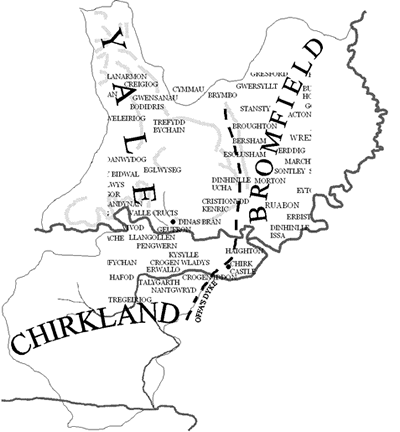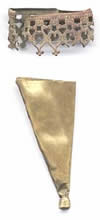|
With the withdrawl of the Romans from Britain
at the end of the 4th century, there was mounting Saxon pressure
from the east and the border area became the ground of many
battles.
By the mid 7th century the Saxon settlers
had driven the Welsh out of the plains and into the foothills
of the mountains.
In the latter half of the seventh and early
part of the eighth centuries, the Welsh made a number of efforts
to reclaim their land, and it was in response to this that
Aethelbald, king of Mercia, built Wat’s Dyke, running
northward along the border from what is now Ruabon.
After his reign was over it appears that
the fortunes of Powys recovered. Eliseg, king of Powys in
the mid eighth century, won a crucial victory against the
English, saving the inheritance of Powys. Offa succeeded Aethelbald
as king of Mercia and also made a number of attacks on the
Welsh border. It was during his reign (757 to 796) that the
remarkable structure known as Offa’s Dyke (a section
of which is shown above) was probably
constructed.
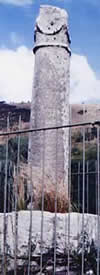 Eliseg’s
great grandson Cyngen, was the last in line of that dynasty
of Powys. He erected a cross in memory of his great grandfather
sometime between coming to power in 808 and his death in 854.
Eliseg’s pillar (shown here), near to Valle Crucis Abbey, is what remains of the cross.
It is one of the oldest inscribed monuments in Wales,
and the valley afterwards became known as Pant y Groes (Valley
of the Cross), after which Valle Crucis Abbey was named. The
cross was knocked down and broken during the civil war of 1642
to 1646, but fortunately Edward Lhuyd recorded the original
inscription, now totally worn away, when he passed the fallen
pillar in 1696. In 1779 the remaining pillar was re-erected by
Edward Lloyd of Trevor Hall and at that time, the tumulus on
which it stands was opened, revealing the skeleton of a tall
man with a gilded skull. The remains were re-interred but the
men who uncovered the body said that the bones 'broke
like gingerbread'. Eliseg’s
great grandson Cyngen, was the last in line of that dynasty
of Powys. He erected a cross in memory of his great grandfather
sometime between coming to power in 808 and his death in 854.
Eliseg’s pillar (shown here), near to Valle Crucis Abbey, is what remains of the cross.
It is one of the oldest inscribed monuments in Wales,
and the valley afterwards became known as Pant y Groes (Valley
of the Cross), after which Valle Crucis Abbey was named. The
cross was knocked down and broken during the civil war of 1642
to 1646, but fortunately Edward Lhuyd recorded the original
inscription, now totally worn away, when he passed the fallen
pillar in 1696. In 1779 the remaining pillar was re-erected by
Edward Lloyd of Trevor Hall and at that time, the tumulus on
which it stands was opened, revealing the skeleton of a tall
man with a gilded skull. The remains were re-interred but the
men who uncovered the body said that the bones 'broke
like gingerbread'.
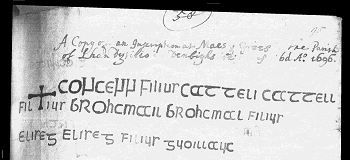 Lhuyd's
transcription (part of which is shown on the left) records a vital piece of history - a
contemporary inscription from the Dark Ages containing a
genealogical record of the kings of Powys that can be compared
with later documents. Lhuyd's
transcription (part of which is shown on the left) records a vital piece of history - a
contemporary inscription from the Dark Ages containing a
genealogical record of the kings of Powys that can be compared
with later documents.
Cyngen, having no children, was succeeded
by Rhodri Mawr (Rhodri the great), son of his sister Nest
and Merfyn, Frych (Merfyn the freckled), and thus the second
ruling house was founded.
At the end of the 9th century Alfred came
to power in England and some of the smaller Welsh rulers asked
for his patronage. It would appear that this included Anarawd
ap Rhodri, king of Gwynedd and Powys.
In 1039 Gruffud ap Llewelyn killed Iago ab
Idwal, great great grandson of Anarawd, and so became ruler
of Gwynedd and Powys. He set his sights further afield, and
by 1057 ruled all of Wales. He also managed to re-claim some
lands beyond Offa’s Dyke, but revenge came in 1063 when
Gruffud was killed by Harold in Snowdonia. Elected king of
England 3 years later, Harold’s victory was short lived,
and everything changed with the coming of the Normans in 1066.
|


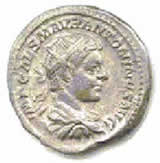
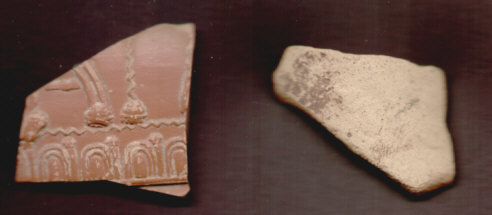

 Eliseg’s
great grandson Cyngen, was the last in line of that dynasty
of Powys. He erected a cross in memory of his great grandfather
sometime between coming to power in 808 and his death in 854.
Eliseg’s pillar (shown here), near to Valle Crucis Abbey, is what remains of the cross.
It is one of the oldest inscribed monuments in Wales,
and the valley afterwards became known as Pant y Groes (Valley
of the Cross), after which Valle Crucis Abbey was named. The
cross was knocked down and broken during the civil war of 1642
to 1646, but fortunately Edward Lhuyd recorded the original
inscription, now totally worn away, when he passed the fallen
pillar in 1696. In 1779 the remaining pillar was re-erected by
Edward Lloyd of Trevor Hall and at that time, the tumulus on
which it stands was opened, revealing the skeleton of a tall
man with a gilded skull. The remains were re-interred but the
men who uncovered the body said that the bones 'broke
like gingerbread'.
Eliseg’s
great grandson Cyngen, was the last in line of that dynasty
of Powys. He erected a cross in memory of his great grandfather
sometime between coming to power in 808 and his death in 854.
Eliseg’s pillar (shown here), near to Valle Crucis Abbey, is what remains of the cross.
It is one of the oldest inscribed monuments in Wales,
and the valley afterwards became known as Pant y Groes (Valley
of the Cross), after which Valle Crucis Abbey was named. The
cross was knocked down and broken during the civil war of 1642
to 1646, but fortunately Edward Lhuyd recorded the original
inscription, now totally worn away, when he passed the fallen
pillar in 1696. In 1779 the remaining pillar was re-erected by
Edward Lloyd of Trevor Hall and at that time, the tumulus on
which it stands was opened, revealing the skeleton of a tall
man with a gilded skull. The remains were re-interred but the
men who uncovered the body said that the bones 'broke
like gingerbread'. Lhuyd's
transcription (part of which is shown on the left) records a vital piece of history - a
contemporary inscription from the Dark Ages containing a
genealogical record of the kings of Powys that can be compared
with later documents.
Lhuyd's
transcription (part of which is shown on the left) records a vital piece of history - a
contemporary inscription from the Dark Ages containing a
genealogical record of the kings of Powys that can be compared
with later documents.